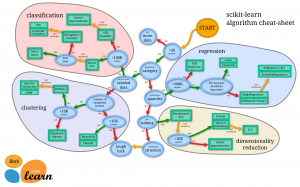
In this post, you will learn about the most common types of machine learning (ML) problems along with a few examples. Without further ado, let’s look at these problem types and understand the details.
- Regression
- Classification
- Clustering
- Time-series forecasting
- Anomaly detection
- Ranking
- Recommendation
- Data generation
- Optimization
| Problem types | Details | Algorithms |
| Regression | When the need is to predict numerical values, such kinds of problems are called regression problems. For example, house price prediction | Linear regression, K-NN, random forest, neural networks |
| Classification | When there is a need to classify the data in different classes, it is called a classification problem. If there are two classes, it is called a binary classification problem. When it is multiple classes, it is multi-nomial classification. For example, classify whether a person is suffering from a disease or otherwise. Classify whether a stock is “buy”, “sell”, or “hold”. Check this related post – Machine learning techniques for stock prediction | Logistic regression, random forest, K-NN, gradient boosting classifier, neural networks |
| Clustering | When there is a need to categorize the data points in similar groupings or clusters, this is called a clustering problem. | K-Means, DBSCAN, Hierarchical clustering, Gaussian mixture models, BIRCH |
| Time-series forecasting | When there is a need to predict a number based on the time-series data, it is called a time-series forecasting problem. A time series is a sequence of numerical data points in successive order. Time series data means that data is in a series of particular time periods or intervals. For example, a time-series forecasting problem is about forecasting the sales demand for a product, based on a set of input data such as previous sales figures, consumer sentiment, and weather. Another kind of time series problem is demand forecasting. | ARIMA, SARIMA, LSTM, Exponential smoothing, Prophet, GARCH, TBATS, Dynamic linear models |
| Anomaly detection | When there is a need to find the outliers in the dataset, the problem is called an anomaly detection problem. In other words, if a given record can be classified as an outlier or unexpected event/item, this can be called an anomaly detection problem. For example, credit card fraud transactions detection is an anomaly detection problem. | IsolationForest, Minimum covariance determinant, Local outlier factor, One-class SVM |
| Ranking | When there is a need to order the results of a request or a query based on some criteria, the problem is ranking problems. We rank the output of query execution based on scores we assign to each output based on some algorithms. These algorithms are called a ranking algorithm. Recommendation engines make use of the ranking algorithm to recommend the next items. | Bipartite ranking (Bipartite Rankboost, Bipartite RankSVM) |
| Recommendation | When there is a need to recommend such as “next item” to buy or “next video” to watch or “next song” to listen to, the problem is called a recommendation problem. The solutions to such problems are called recommender systems. | Content-based and collaborative filtering machine learning methods |
| Data generation | When there is a need to generate data such as images, videos, articles, posts, etc, the problem is called a data generation problem. | Generative adversarial network (GAN), Hidden Markov models |
| Optimization | When there is a need to generate a set of outputs that optimize outcomes related to some objective (objective function), the problem is called an objective function. | Linear programming methods, genetic programming |
Latest posts by Ajitesh Kumar (see all)
- Coefficient of Variation in Regression Modelling: Example - November 9, 2025
- Chunking Strategies for RAG with Examples - November 2, 2025
- RAG Pipeline: 6 Steps for Creating Naive RAG App - November 1, 2025
I found it very helpful. However the differences are not too understandable for me